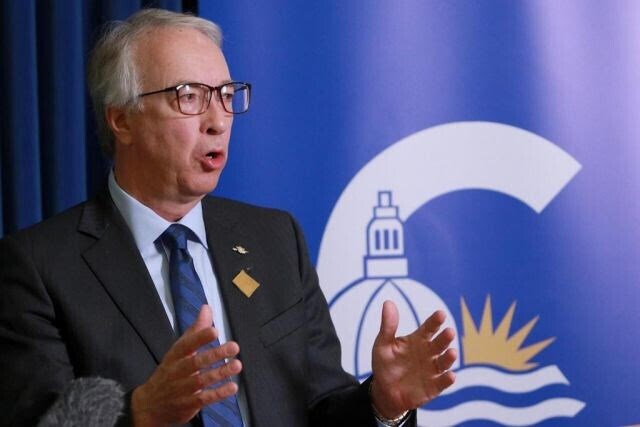The provincial elections that have taken place in this century in British Columbia have provided opportunities to test a dominant centre right-party against a dominant centre-left party. The shows that, in 2024, these two political forces are the Conservative Party of BC and the BC NDP.
We recently asked British Columbians to place themselves on the political spectrum. Practically two-thirds of respondents select centre (33 per cent), centre-right (16 per cent) or centre-left (16 per cent). Significantly fewer residents see themselves as right (10 per cent), extreme right (four per cent), left (10 per cent) or extreme left (two per cent).
Where we see ourselves is very different from where we place existing political parties. One-third of British Columbians (33 per cent) brand the BC NDP as left or extreme left, while almost half (46 per cent) deem the BC Conservatives as right or extreme right.
The BC Green Party is regarded as centre or centre-left by more than a third of British Columbians (37 per cent), but more than three in 10 (31 per cent) position it as left or extreme left. BC United is centre or centre-right for 32 per cent of British Columbians, with 21 per cent branding it as right or extreme right.
When British Columbians are asked to apply the same ideological lens to the four individuals leading the main provincial parties, there are some slight fluctuations.
Premier and BC NDP leader David Eby is seen as left or extreme left by 29 per cent of British Columbians, four points behind the total for the party he commands. A similar situation ensues for John Rustad of the BC Conservatives: 43 per cent brand him as right or extreme right, three points lower than his party.
In the case of BC Greens leader Sonia Furstenau, her individual numbers do not vary much from her party’s. We see that 49 per cent of British Columbians define the BC Greens as centre-left, left or extreme left, and 47 per cent place Furstenau in the same categories. BC United’s Kevin Falcon yields similar results: 48 per cent see his party as centre-right, right or extreme right and 46 per cent feel the same way about him.
While a third of British Columbians claim to be centre, no party comes close to reaching that level. The BC Greens are at 21 per cent, and BC United and the BC NDP are tied with 17 per cent. This is not unexpected for a province like British Columba. Standing for something, even if it risks being seen as “radical” by other voters, is politically more convenient than trying to be a “middle of the road” option.
What British Columbians think of Eby, Rustad, Furstenau and Falcon
We also asked individually about the character traits of the four party leaders. At least two in five British Columbians think Eby is a good speaker and communicator (52 per cent), has a vision for the future of the province (44 per cent), understands the problems of ÎÚÑ»´«Ã½ residents (41 per cent), is a strong and decisive leader (40 per cent) and is honest and trustworthy (also 40 per cent).
Among the other leaders, no universal challenger emerges. Furstenau does better on vision (36 per cent) and honesty (34 per cent), Falcon on effective communication (36 per cent) and Rustad on decisiveness (30 per cent). Eby is also ahead on being in touch with the problems of residents (37 per cent, with Furstenau at 30 per cent and Rustad and Falcon at 29 per cent each) and sharing their values (35 per cent, with Furstenau at 30 per cent, Rustad at 27 per cent and Falcon at 25 per cent).
A silver lining for the opposition appears on two questions. On economic management. Eby is first at 33 per cent—his lowest grade among 11 indicators tested—with Rustad at 29 per cent and Falcon at 27 per cent. Eby is seen as patronizing by 29 per cent of British Columbians, tied with Rustad and a point below Falcon, with the best showing (in this case, the lowest) belonging to Furstenau (20 per cent).
Campaigns always provide an opportunity for improvement. In previous elections I have covered, the needle barely registered in the early stages for leaders who ended up winning, such as Rachel Notley of the Alberta NDP and Justin Trudeau of the federal Liberal Party in 2015. In the United States, Democratic Party nominee Barack Obama consistently led Republican Party challenger Mitt Romney on these traits during the 2012 presidential campaign—with the glaring exception of economic management.
At this point, British Columbia’s electorate appears to be making a decision based on the customary ideological options before it. If a true challenger to Eby can emerge on indicators such as finances, vision and honesty, the election will be decidedly more competitive than the last one.
Mario Canseco is president of Research Co.
Results are based on an online study conducted from June 17-19, 2024, among 800 adults in British Columbia. The data has been statistically weighted according to Canadian census figures for age, gender and region in British Columbia. The margin of error—which measures sample variability—is plus or minus 3.5 percentage points, 19 times out of 20.



